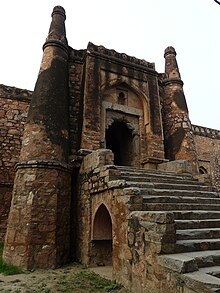Khirki Mosque (Delhi)

The Khirki Mosque ( Urdu : Khirki Masjid ) is a fortress-like mosque in the old district of Jahanpanah in the south of the Indian capital Delhi . The Urdu word khirki means "window" and so a German translation would be "mosque of windows".
location
The mosque is located within a residential area about 13 km south of New Delhi and about 3.5 km east of the Qutb complex . The Begumpur Mosque , the Choir Minar and the Baha'i Lotus Temple are all within a 5 km radius.
Building history
The mosque was probably built around 1351 (according to other dates around 1375/80) by Khan-i-Jahan Maqbul Tilangani, called Malik Maqbul , the vizier or "First Minister" of Firuz Shah Tughluq (r. 1351-1388), the fourth sultan of the Tughluq dynasty , donated. Both the sultan and his vizier - born as a Hindu but converted to the Islamic faith - distinguished themselves as builders of several mosques and tombs. The mosque was thoroughly restored by the Archaeological Survey of India around 2010 - collapsed parts of the vault were renewed and the vault was plastered with 50% clay and 50% crushed bricks.
architecture
Exterior construction
The Khirki Mosque, built on a square substructure with a side length of around 52 meters, differs from all other mosques in India in its almost fortress-like character and - apart from four inner courtyards - the construction that is closed and roofed on all sides. The building has three portals on the north, east and south side, accessible via bridge-like stairs; therefore it has been assumed that the mosque was once bathed in water. The portals are laterally accompanied by round towers on an octagonal substructure, which have a minaret-like character, but cannot be used as such due to their massive construction. In the corners of the building - topped with a crenellated wreath - rise four stair towers, which are more reminiscent of guard or fortified towers due to their almost closed construction.
inner space
Despite the four open courtyards that provide light and ventilation for the building, the interior of the mosque is bathed in shady darkness. The windows are closed by thick blinds and give only a little light. On the west side of the mosque is the mihrab niche, which protrudes slightly outwards . Parts of the mosque are flat-roofed; A total of 81 small domes can be found above the bays in the middle, the corners, in front of the mihrab and above the portal zones.
Like many other mosques, the Khirki-Masjid does not have any decoration that could have distracted the worshipers during prayer. Even the pillars and capitals look less elegant, but rather bulky.
photos
See also
- Begumpur Mosque (Delhi)
- 'Sixty-Dome Mosque' in Bagerhat , Bangladesh
literature
- Martin Frishman, Hassan-Uddin Khan (ed.): The mosques of the world. Campus-Verlag, Frankfurt / New York 2002, ISBN 3-89340-024-9 , p. 164.
- R. Nath: History of Sultanate Architecture. Abhinav Publications, New Delhi 1978, OCLC 4455774 , pp. 52-55.
Web links
- Khirki Mosque - Photos + Info (Archnet, Engl.)
- Khirki Masjid - Photo + Infos (Engl.)
- The Tughluqs - History + Buildings (Archnet document, English)
Coordinates: 28 ° 31 '53 " N , 77 ° 13' 11" E





